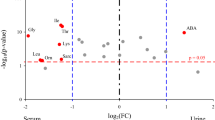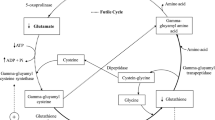Abstract
Previous studies showed that large amounts of phenylcarboxylic acids (PhCAs) are accumulated in a septic patient’s blood due to increased endogenous and microbial phenylalanine and tyrosine biotransformation. Frequently, biochemical aromatic amino acid transformation into PhCAs is considered functionally insignificant for people without monogenetic hereditary diseases. The blood of healthy people contains the same PhCAs that are typical for septic patients as shown in this paper. The overall serum PhCAs level was 6 μM on average as measured by gas chromatography with flame ionization detection. This level is a stable biochemical parameter indicating the normal metabolism of aromatic amino acids. The concentrations of PhCAs in the metabolic profile of healthy people are distributed as follows: phenylacetic ≈ p-hydroxyphenyllactic > p-hydroxyphenylacetic > phenyllactic ≈ phenylpropionic > benzoic. We conclude that maintaining of stable PhCAs level in the serum is provided as the result of integration of human endogenous metabolic pathways and microbiota.
Similar content being viewed by others
Abbreviations
- BA:
-
benzoic acid
- 3,4-DHBA:
-
3,4-dihydroxybenzoic acid
- GC-FID:
-
gas chromatography with flame ionization detection
- GC-MS:
-
gas chromatography coupled with mass spectrometry
- IR:
-
interquartile range
- PAA:
-
phenylacetic acid
- PhCAs:
-
phenylcarboxylic acids
- p-HPAA:
-
p-hydroxyphenylacetic acid
- p-HPPA:
-
p-hydroxyphenylpropionic acid
- p-HPLA:
-
p-hydroxyphenyllactic acid
- PLA:
-
phenyllactic acid
- PPA:
-
phenylpropionic acid
- PR:
-
percentile range
- TMS:
-
trimethylsilyl
References
Beloborodova, N. V., Olenin, A. Yu., Khodakova, A. S., Chernevckaya, Ek. A., and Khabib, O. N. (2012) The origin and clinical significance of low molecular weight phenolic metabolites in human serum, Anesteziol. Reanimatol., 5, 65–72.
Simon, R., Wetzel, W., Winsey, K., Levenson, S. M., and Demetriou, A. A. (1987) Supplemental dietary tyrosine in sepsis and acute hemorrhagic shock, Arch. Surg., 122, 78–81.
Williams, R. A., Mamotte, C. D., and Burnett, J. R. (2008) Phenylketonuria: an inborn error of phenylalanine metabolism, Clin. Biochem. Rev., 29, 31–41.
Kitagawa, T. (2012) Hepatorenal tyrosinemia, Proc. Jpn. Acad. Ser. B Phys. Biol. Sci., 88, 192–200.
Beloborodova, N. V., Khodakova, A. S., Bairamov, I. T., and Olenin, A. Y. (2009) Microbial origin of phenylcarboxylic acids in the human body, Biochemistry (Moscow), 74, 1350–1355.
Khodakova, A., and Beloborodova, N. (2007) Microbial metabolites in the blood of patients with sepsis, Crit. Care, 11(Suppl. 4), 5.
Beloborodova, N. V., Osipov, A. A., and Bedova, A. Yu. (2013) Biological properties of certain low molecular weight aromatic microbial metabolites associated with sepsis, Antibiot. Khimioterap., 7/8, 36–49.
Beloborodova, N. V. (2012) Integration of metabolism in man and his microbiome in critical conditions, Obshch. Reanimatol., 4, 42–54.
Cueva, C., Moreno-Arribas, M. V., Martin-Alvarez, P. J., Bills, G., Vicente, M. F., Basilio, A., Rivas, C. L., Requena, T., Rodriguez, J. M., and Bartolome, B. (2010) Antimicrobial activity of phenolic acids against commensal, probiotic and pathogenic bacteria, Res. Microbiol., 161, 372–382.
Dieuleveux, V., Lemarinier, S., and Gueguen, M. (1998) Antimicrobial spectrum and target site of D-3-phenyllactic acid, Int. J. Food Microbiol., 40, 177–183.
Fedotcheva, N. I., Kazakov, R. E., Kondrashova, M. N., and Beloborodova, N. V. (2008) Toxic effects of microbial phenolic acids on the functions of mitochondria, Toxicol. Lett., 180, 182–188.
Beloborodova, N., Bairamov, I., Olenin, A., Shubina, V., Teplova, V., and Fedotcheva, N. (2012) Effect of phenolic acids of microbial origin on production of reactive oxygen species in mitochondria and neutrophils, J. Biomed. Sci., 19, 89.
Schmidt, S., Westhoff, T. H., Krauser, P., Zidek, W., and van der Giet, M. (2008) The uraemic toxin phenylacetic acid increases the formation of reactive oxygen species in vascular smooth muscle cells, Nephrol. Dial. Transplant., 23, 65–71.
Jenner, A. M., Rafter, J., and Halliwell, B. (2005) Human fecal water content of phenolics: the extent of colonic exposure to aromatic compounds, Free Radic. Biol. Med., 38, 763–772.
Knust, U., Erben, G., Spiegelhalder, B., Bartsch, H., and Owen, R. W. (2006) Identification and quantitation of phenolic compounds in faecal matrix by capillary gas chromatography and nano-electrospray mass spectrometry, Rapid Commun. Mass Spectrom., 20, 3119–3129.
Sarshor, Y. N., Beloborodova, N. V., Bedova, A. Y., Osipov, A. A., Chernevskaya, E. A., and Getsina, M. L. (2013) New criteria of bacterial load in critically ill patients, Shock, 40(Suppl. 1), 31.
Beloborodova, N. V., Bairamov, I. T., Olenin, A. Y., Khabib, O. N., and Fedotcheva, N. I. (2013) Anaerobic microorganisms from human microbiota produce speciesspecific exometabolites important in heath and disease, Global J. Pathol. Microbiol., 1, 43–53.
Moroz, V. V., Beloborodova, N. V., Bedova, A. Y., Revelsky, A. I., Getsina, M. L., Osipov, A. A., Sarshor, Y. N., Buchinskaya, A. A., and Olenin, A. Y. (2015) Development and adaptation to clinical laboratories of GC methods for determination of phenylcarboxylic acids in blood serum, Zh. Analit. Khim., 4, in press.
Nasledov, A. (2013) IBM SPSS Statistics 20 and AMOS: Professional Statistical Analysis of the Data [in Russian], Piter, St. Petersburg.
Lang, T. A., and Sesik, M. (2011) How to Describe Statistics in Medicine [Russian translation] (Leonov, V. P., ed.) Prakticheskaya Meditsina, Moscow.
Vente, J. P., von Meyenfeldt, M. F., van Eijk, H. M., van Berlo, C. L., Gouma, D. J., van der Linden, C. J., and Soeters, P. B. (1989) Plasma-amino acid profiles in sepsis and stress, Ann. Surg., 209, 57–62.
Jeevanandam, M., Young, D. H., Ramias, L., and Schiller, W. R. (1990) Effect of major trauma on plasma free amino acid concentrations in geriatric patients, Am. J. Clin. Nutr., 51, 1040–1045.
Askanazi, J., Carpentier, Y. A., Michelsen, C. B., Elwyn, D. H., Furst, P., Kantrowitz, L. R., Gump, F. E., and Kinney, J. M. (1980) Muscle and plasma amino acids following injury: influence of intercurrent infection, Ann. Surg., 192, 78–85.
Smith, E. A., and Macfarlane, G. T. (1996) Enumeration of human colonic bacteria producing phenolic and indolic compounds: effects of pH, carbohydrate availability and retention time on dissimilatory aromatic amino acid metabolism, J. Appl. Bacteriol., 81, 288–302.
Jones, M. R., Kopple, J. D., and Swendseid, M. E. (1978) Phenylalanine metabolism in uremic and normal man, Kidney Int., 14, 169–179.
Griffiths, L. A., and Barrow, A. (1972) Metabolism of flavonoid compounds in germ-free rats, Biochem. J., 130, 1161–1162.
Wikoff, W. R., Anfora, A. T., Liu, J., Schultz, P. G., Lesley, S. A., Peters, E. C., and Siuzdak, G. (2009) Metabolomics analysis reveals large effects of gut microflora on mammalian blood metabolites, Proc. Natl. Acad. Sci. USA, 106, 3698–3703.
Author information
Authors and Affiliations
Corresponding author
Additional information
Published in Russian in Biokhimiya, 2015, Vol. 80, No. 3, pp. 449–455.
Rights and permissions
About this article
Cite this article
Beloborodova, N.V., Moroz, V.V., Osipov, A.A. et al. Normal level of sepsis-associated phenylcarboxylic acids in human serum. Biochemistry Moscow 80, 374–378 (2015). https://doi.org/10.1134/S0006297915030128
Received:
Revised:
Published:
Issue Date:
DOI: https://doi.org/10.1134/S0006297915030128




